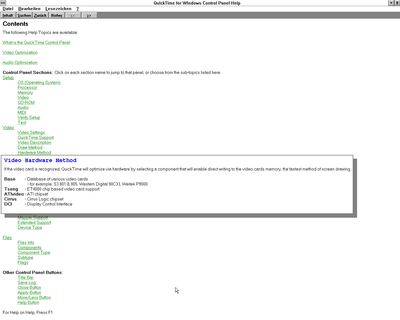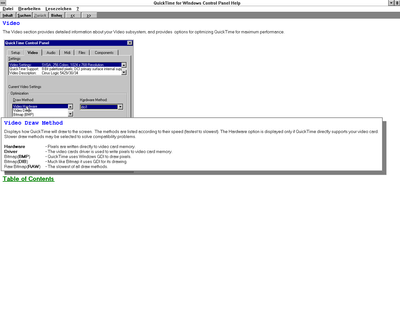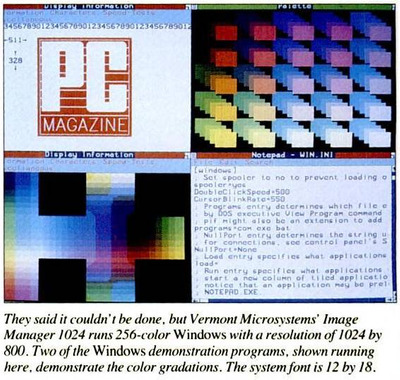@rasz_pl Hi there! I'm afraid you're thinking too much DirectX style here.. 😅
Early "accelerators" like PGC, 8514/A or TIGA weren't so much about speed/throughput, but about lowering CPU load and lowering the bandwidth needed.
They also allowed graphics to look more pretty, without sacrificing workflow (think of shading, high colour depths etc).
I think it's accurate what Grzyb said about ISA bus and high resolutions/colour-depths.
Windows, at the time, was used as an intelligent graphics library or framework, essentially.
The wonderful thing was that Windows devices, like printers, were available to all Windows applications.
- GDI was used for printers, too. All in all, Windows was like a hardware abstraction/emulation layer (HAL, HEL) at the time.
That was the main purpose or original purpose of GDI, after all. Hardware-Independency.
Also, a simple "set pixel" can be accelerated by intelligent hardware, too. It's not mandatory to use sprites or tiles to make that work.
Smart Windows drivers use tricks like dirty rectangle (merely update parts of screen that have changed). Standard VGA driver does it, too.
The early Windows Accelerators did implement some form of blitting, too, which was handy for drawing large bitmaps on screen.
Some accelerators also had a video memory that held parts of the Windows GUI, like fonts or the windows decorations (minimize, maximize icons etc).
The mouse cursor was also implemented in hardware.. All this little things helped to improve the user experience.
rasz_pl wrote on 2023-04-16, 04:54:As cited earlier video worked really bad until one year before win95, September 1994 when Microsoft shipped stolen Quicktime cod […]
Show full quote
Jo22 wrote on 2023-04-15, 19:27:
CD-ROM technology also was a hot thing. Let's just think about Kodak Photo CD, CD-i and Video CD, they pioneered in the Windows 3.0 MME/3.1 days. Years before Windows 95 was around.
As cited earlier video worked really bad until one year before win95, September 1994 when Microsoft shipped stolen Quicktime code 😀.
All Windows 3.0 MME did in 1991 was MCI, standardized control of external players and overlay - Im thinking punching a chroma-keyed window?
If you wanted any kind of video on Windows before 1994 you needed additional hardware decoder card plugged into Feature connector,
meanwhile on Mac things worked couple years earlier on stock cpu and build in graphic hardware. 1991 release of QuickTime set Apple as the leading video platform, some notable examples are 1991 Adobe Premiere (build by ex Quicktime engineer), 1991 Avid (ported from Apollo $workstations$), 1992 https://en.wikipedia.org/wiki/CU-SeeMe.
I'm not sure if that's the whole story.
It's not as if we lived in a stone age before Windows 95 was around. 🤣 No, things rather gradually evolved over the years.
Windows 3.0 was a breakthrough, but even Windows 1.0 had hi-def applications at some point.
There was video conferencing done on Windows 3.1x before Windows 95, even.
Video worked fine before Windows 95, as far as I can tell.
There was DCI, a video driver specificiation/feature, which was used by Xing MPEG Player (if available) - to name a popular application.
WinG (another technology) was used in both Windows 3.x and Windows 95 days. Alternatively, there was WinDirect API, albeit less popular.
CAD/CAM programs had their own APIs, which some of the graphics card boxes of the era do mention.
Windows 3.0 MME shipped with .MMM codec for playing animations in 1991.
Autodesk Animation Player for Windows (AAPLAY/WIN) was available since 1990/1991 and ran on plain Windows 3.0.
The original Video for Windows, v1.0, released in 1992 runs on 80286 PCs and needs no hardware decoder.
Not for the supplied Video 1 codec, at least.
Besides Video for Windows and QuickTime, there also was Ultimotion codec for OS/2 2.11/Warp and Windows 3.1x.
And there was Real Player on Windows 3.1/95. It was used as an alternative to QuickTime at the time (mid 90s, introduced about '94-'96).
Both were available as browser plug-ins for Netscape 2.x, as well. Real Player also was popular for web radio and web audio (*.RA, real audio).
MPEG boards and video compression boards were mainly needed to create content.
Ideally, the PCs also had them for playing back MPEG/Video CD in real-time, stutter-free (no frameskip) in full colour.
On a low-end system with poor CPU/graphics, things like dithering could have unnecessarily slowed down software-decoding at the time.
That's why even the Philips CD-i player had a dedicated MPEG module in a slot, for playing MPEG-1/Video CD.
CD-i video discs, by contrast, did work without that digital video cartridge, maybe. Have to check.
Macintoshs needed System 7 and an 68040 or higher CPU for playing back Video CD, I vaguely remember.
They also needed an MPEG decoder in the early days, I believe.
But when 486 PCs became more and more powerful, software decoding became a real alternative.
Xing MPEG Player is/was such an alternative at the time (Windows 3.1 and 95 versions available; 95 version supported MMX later on).
The upcoming PCI graphics cards often had video features, such as colour conversion, hardware-zoom etc.
But what exactly does "stole Quicktime code" actually mean ? Who ported QuickTime to Windows ? Was there a license agreement involved ?
Microsoft and Apple had an ambivalent relationship in history, always blaming the other. Didn't they both stole in one way or another ? 😀
The TrueType font technology found its way into both Windows 3.1 and System 7, too. There were so many parallels between both platforms, anyway.
Edit: Didn't QuickTime itself support DCI enabled drivers, among other things ? Why support such an "illegal" technology ?
PS: It's not easy to name all use cases for hi-def Windows graphics.
The most fitting answer might be "for about everything".
Things that come to mind..
Communications programs for services like AOL, Prodigy, CompuServe or T-Online.
They made use of animations, buttons, GIF pictures, colour gradients etc.
In short, were graphics intensive and used GDI resources.
Kodak Photo CD supported pictures in up to 4096×6144 pels resolution, 24-Bit colour depth,
now try do display those 70 MB worth of data on an unaccelerated system in 1993! 😜
Then, Windows programming in Visual Basic 1-3 really flourished in the years before Windows 95.
There was a huge market for VBX extensions, too. Making your own pretty Windows applications was easy before Windows 95.
The visual part, at least. The form designer was fun to use, bitmaps, sounds and MIDI could be easily embedded.
Long story short, it made multi media programming easy as pie. Only the hardware was the limit.
This was something very unique to the 16-Bit era, I think. It was very playful and colourful.
Some people may also used Windows as an interface for house automation.
Which means, big pictures and buttons for the graphical interface, etc.



